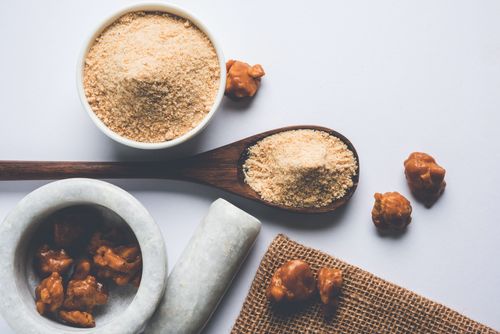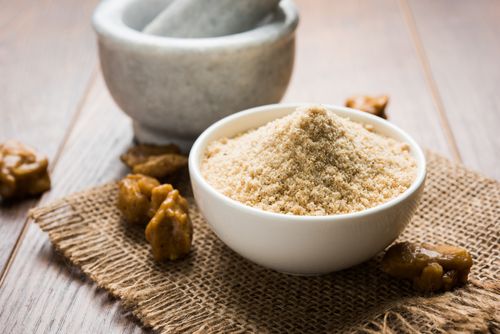Asafoetida: The Spice that is Loved in India
Asafoetida or Hing is also known as devil’s dung, stinking gum, food of the gods & jowani badian. It is a spice, which is extracted from Ferula Asafoetida. Once dried, the gum is grounded into a coarse powder popularly known as Hing. Asafoetida is native to central Asia, eastern Iran to Afghanistan; in India, it is mainly cultivated in Kashmir and Punjab.
Asafoetida or Hing is an integral part of Indian cuisines and has medicinal benefits as well. Asafoetida has a strong, pungent smell due to the presence of the sulphur compound. It gives a distinct flavour to curries and has numerous health benefits as well.
The popularity of Asafoetida/Hing in India
Indian households and hing have a long relationship that goes back to hundreds of years. Indians use hing in daily cooking. No tadkaa is complete without the aroma of hing in it. This pungent spice adds an aromatic flavour to any dish and takes it a notch higher. Asafoetida is extensively used in vegetarian cooking. Dishes like dal, vegetable curries, kadhi are some of the dishes where asafoetida is a compulsory ingredient.
Asafoetida or hing not only adds a distinct flavour to the food but it also helps to cure indigestion. Asafoetida is added to dishes that are difficult to digest. Due to its medicinal properties, it helps to relieve digestive problems. Hing is also used as a substitute for garlic and ginger by those avoiding it during religious fasts or gatherings.
Usage of Asafoetida in Different Regions in India
Hing came to India via the Silk Route and became an intrinsic part of the culture and cuisine. People use asafoetida to add flavor to their food. In northern India, hing is used in deep-fried foods like kachori, poori, pakora batter, etc to prevent stomach related issues. In eastern parts of the country, hing is used in non-vegetarian meals to add flavor and aroma to the dish. And, in south India, hing is used in sambhar, vada, etc because these pulse-based dishes tend to create gastric problems.
10 Health Benefits of Asafoetida/Hing
1. Asafoetida Aids in Digestion
Hing is an age-old medicine for stomach problems. Hing has anti-inflammatory and anti-spasmodic properties that help relieve problems like bloating, gas, irritable bowel syndrome, flatulence, etc. Consume hing daily by adding it to your curries and dals.
2. Relieves Cough and Cold
Hing is hot in nature. It has anti-bacterial and anti-inflammatory properties that help in relieving chest congestion. It is great for people suffering from asthma and can help cure it completely.
3. Relieves Menstrual Pain
Hing is a natural blood thinner and ensures proper blood flow throughout your body. It also promotes progesterone production in the body and provides relief in menstrual cramps.
4. Lowers Blood Pressure Levels
Hing has a compound called ‘coumarin’ that improves blood flow. Proper blood flow in the body ensures a good blood pressure level.
5. Prevents Respiratory Problems
Hing has antibacterial, antifungal and antimicrobial properties, which help in keeping the respiratory tract clear of pathogens. It boosts the production of antibodies in our bodies.
6. Great for Skin
Hing is loaded with antioxidants and antioxidants are great for the skin. Mix a pinch of hing in your face pack and get that glowing skin.
7. Treats Allergies
Hing has anti-bacterial and anti-fungal properties. It can cure skin allergies caused due to sun damage or other factors.
8. Healing Benefits
Hing is herbal medicine. Studies have shown its effect on healing wounds and burns. You can directly apply a paste of hing and water on the wounds to reduce pain and induce healing.
9. Prevents Acidity
Hing is alkaline and helps to relieve acid reflux in the body. It also prevents gastric and other stomach-related problems.
10. Increases Metabolism
Hing has immense health benefits, and it improves the body’s metabolism. It improves immunity and keeps the body healthy.
Asafoetida/Hing for Reducing Stomach Ache in Babies
Babies often suffer from gastric problems when they are primarily on mother’s milk. It leads to colic pain. Hing is completely safe for infants. But it should not be administered orally. Babies below 10 months should not be fed hing orally as their digestive system is too weak to handle it. If your baby is facing tummy issues, make a paste of hing with water and apply it to your baby’s tummy. Gently massage it around the navel area and leave it for a few minutes.
After the paste dries, wipe it with a cloth and make your baby burp. Hing possesses potent antibacterial properties, which can regulate the imbalances in the stomach lining. It provides quick relief to babies from stomach aches and pooping problems.
How to Consume Asafoetida?
Hing is a common spice found in Indian households. The amount of hing to be used is very minute as it is a potent spice and used in small amounts.
Ways to Consume Hing:
- You can drink a glass of lukewarm water with a pinch of asafoetida/hing regularly to cure acidity, bloating, and other digestive issues.
- You can add a big pinch of asafoetida/hing in the tempering for your vegetables, curries, snacks, and even drinks to boost your metabolism.
- Hing is a natural blood thinner. Drink asafoetida/hing water regularly to keep your blood pressure in control and prevent hypertension.
- You can also apply asafoetida/hing paste on your face to get that spotless glow.
Benefits of Asafoetida/Hing Tadkaa
Hing is famous for its digestive properties. When it is used as tempering in dal or curries, it not only enhances the taste but also provides immense health benefits. The aroma of the sizzling tadkaa sets the mood for the food and makes us hungry.
Known by many names such as chhounk, tadka, baghaar, phodni, thaalippu, etc. throughout India, Tadkaa is an important part of many dishes. For tadkaa, ghee or oil is heated in a pan, a bunch of spices such as rai (mustard seeds); hing (asafoetida), jeera (cumin seeds), etc. are added to this hot oil/ghee, which unlocks the unique aroma of the spices. This process helps our body process the fat-soluble vitamins in the spices.
When the spices come in contact with hot oil or ghee, they are broken down which makes it easier for the vitamins to get absorbed in the body. If spices are cooked for a longer amount of time with the dish, they lose their health benefits.
Can We Eat Asafoetida/Hing Raw?
Hing is a pungent hot spice. It is difficult to eat it raw because of its bitter taste and strong smell. Experts recommend consuming asafoetida/hing in a diluted form. You can add asafoetida/hing in your tadkaa or add it in lukewarm water. It is only in oil or ghee that spices like asafoetida/hing break down and our body can reap all its benefits.
Summary
Hing and its manifold benefits make it a super spice. It is widely used around the world to add flavor to the dishes. Asafoetida also has great health benefits and is widely used in traditional medicines such as Ayurveda. It has excellent digestive properties and is a boon for people suffering from constipation or digestive ailments. It has anti-bacterial properties that help to cure a cold and flu. Our grandmothers have always advised us to include asafoetida/hing and other similar spices in our everyday meals due to their great health benefits.
Hing is not just a spice but also a medicinal herb. We often take these common spices for granted, but they have great health benefits. Asafoetida not only works wonders for the body but can also cure various skin and hair problems. These numerous benefits make asafoetida/hing nothing less than a wonder spice. Include asafoetida/hing in your diet and see your health improving in no time.
Common issues like bloating, bowel movements, acid reflux, stomachaches in babies etc can be cured with just a pinch of asafoetida/hing. Like all good things have some side effects, similarly too much of hing can cause you some mild issues. So consume asafoetida/hing in moderation and let it work its magic on your health.
Frequently Asked Questions (FAQs)
A. Hing is a pungent hot spice. It is difficult to eat it raw because of its bitter taste and strong smell. Experts recommend consuming it in a diluted form. You can add it to your tadkaa or have it with lukewarm water. It is only in oil or ghee that spices like hing break down and our body can reap all its benefits.
A. Hing is an age-old medicine for stomach problems. It has anti-inflammatory and antispasmodic properties that help relieve problems like bloating, gas, irritable bowel syndrome, flatulence, etc. Consume asafoetida/hing daily by adding it to your curries and dal to get rid of any digestive problems.
A. You can drink a glass of lukewarm water with a pinch of asafoetida/hing regularly to cure acidity, bloating, and other digestive issues. Add asafoetida/hing regularly to your diet by using it in tempering for vegetables, curries, snacks, and even drinks to boost your metabolism. Drink asafoetida/hing water regularly to keep your blood pressure in control and prevent hypertension.
A. Babies often suffer from gastric problems when they are primarily on mother’s milk. It leads to colic pain. Hing is completely safe for infants. But it should not be administered orally as their digestive system is too weak to handle it. If your baby is facing tummy issues, make a paste of asafoetida/hing with water and apply it to your baby’s tummy. Gently massage it around the navel area and leave it for a few minutes. After the paste dries, wipe it with a cloth and make your baby burp.
A. Asafoetida/Hing is famous for its digestive properties. When it is used as tempering in dal or curries, it not only enhances the taste but also provides immense health benefits. The aroma of the sizzling tadkaa sets the mood for the food and makes us hungry.



